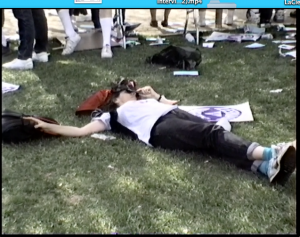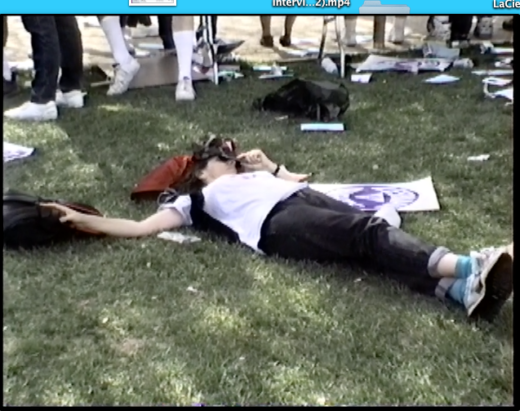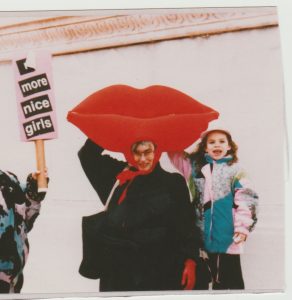Item Data
Even if Lesbian Home Movie Project’s first collection had been a talkie, the only way to have known for sure that at least some of the women in it were lesbian would have been to have known the filmmaker or at least one of the women in the footage. As it happened, I did know one fairly well. Friends knew others better. One’s mother had even slept with the filmmaker. Another, Sheila McLaughlin, had first known the filmmaker when Sheila was a very little girl. (The Ruth Storm Collection clip below shows Meda on the left, Sheila in a beret watering a garden, Sheila’s mother washing a station wagon, soon joined by Ruth Storm.)
The luck of those connections led us to restrict our collections to those with primary sources who could tell about the filmmakers and participants and point the way to others who could also help with documentation. To date only one film donor reneged on that agreement.
The resulting voluminous records would make it easy to create the finding aids and obtain the participant releases to stream that Women Behind the Camera required, we assumed. To a degree that’s proved true. At the same time, an oral history approach has weaknesses that an archival approach quickly brings to glaring light.
Oral histories dive deep fast. They go straight to story: what was going on in a situation, what the speaker made of it, who was important to her. Interrupting the process of recollection to pin down details is counterproductive as a rule, particularly if a witness is older and fears, as almost everyone older does, that memory is failing. To start an interview with detailed questions is almost always to get off on the wrong foot. It’s too formal and intimidating. Ending with specific questions feels rude. It cuts the strong feelings conversation almost always evokes short. It signals that the listener is not a friend, after all. It has been an instrumental exchange not a heart to heart. For these reasons, I usually rely on email and phone follow-up to gather basic facts, sending clips and screen shots by email: Is this Barbara? What was her last name? Address? Phone number? Can you think of anyone who might? It’s laborious and it doesn’t always work.
Following filmmakers’ explicit and implicit wishes can create other shortfalls. If a filmmaker is reluctant for us to follow up on a lead, we usually don’t and there’s almost always reluctance involved in any project that depends on snowball sampling. Everyone knows someone they’d rather not officially opine on their life. One can press. But for Lesbian Home Movie Project respecting the wishes of filmmakers and donors takes precedence, in part out of this pragmatism: We’ll only be trusted with more collections if filmmakers and donors tell friends that we should be, and our primary goal is to save as much relevant footage as possible.
Exacerbating the double bind created by the goals of research, preservation, and accessibility for the CLIR-funded Woman Behind the Camera project was the fact that we used the funding in part to finance digitizing two large new collections — the Corky Culver and Shirley Lasseter collections. Together these two collections open an extraordinary window on lesbian and feminist political efforts and hijinks in the south. They were profoundly worth saving. But for the most part, they’re tape collections and involve hundreds of participants in events that at first review seemed “public” — i.e., more or less okay to stream — but in fact had restricted attendance by gender — which arguably made them private events. In addition, some wholly public events in the tapes involved actions not strictly speaking legal; for example, a group going out late at night with spray cans of paint to emblazon a highway wall with feminist and gay slogans and symbols. Decades later not everyone wanted to flaunt what they’d done. Nudity raised another issue, especially toplessness. In the feminist context of the time, going topless meant claiming the freedom men had always had. In a streaming context, many filmmakers and participants fear it being read, and used, as pornographic, a repugnant idea to many. On top of that, many of the hundreds of participants in the new collections had moved on, often changing their names in the process. Appearances, too, had changed, of course. And there was the problem of dating footage. Super 8 and 8mm reels are usually shot on one occasion. VHS and hi 8 tapes are often shot on several occasions, not necessarily in the same year or even decade.
Long story short, we’ve spent more than a year combing through those two collections and going back over our earlier ones, pulling clips & screenshots, and asking filmmakers and donors, who was this? when do you think this was? where? It has not been easy. While home movies and amateur films often function as diaries, and as a rule tape equipment has offered the option of dating footage, that option is often ignored and frequently misapplied. It’s not unusual for a tape collection to show the date of purchase as the date of every tape, for example. One filmmaker actually kept journals as well but she didn’t use dates in those either. What about a chronology of your relationships, I finally asked. Bingo. By return email, she sent the approximate years of her most lasting loves. Not the most precise guide to dating footage but in a pinch . . . . We often found ourselves in the chronological dark, however, and we didn’t always come up with such a neat solution. Thank heavens for “circa.”
Hoping to venture beyond immediate sources, we attempted a variation on an approach Melissa Dollman presented at a talk at the 2017 Northeast Historic Film Symposium: posting inquiries about clips on the web. Dollman’s approach is website-based and very elegant. http://communityhistories.org/rocky-mount-mills-project/community-input-on-rocky-mount-mills-and-village-home-movie/
Because our website was — still is! — still in construction, our approach has had to rely on social media.
We began to post carefully chosen screen shots and short clips on my personal fb page and on our project page — Lesbian Home Movie Project (LHMP). Lesbian and feminist worlds are large, of course, but they are also interconnected, and despite fb’s now notorious flaws, the fb approach has proven a remarkably effective approach to finding participants. It has also created an inevitable amount of uncertainty. If Hillary knew Janet when they were 19, Hillary may not be positive that she’s watching the Janet of age 55, and she may not know anything about Janet’s life between 19 and 55. Similarly if Suzanne knew Hillary at age 55, she may not be sure that’s the 19-year-old Hillary bounding around in that field of bluets. This lesson was twice underscored a few weeks ago. First example: I came upon a series of interviews that took place in California and was suddenly startled to hear a woman named Sunlight say that she used to live in New York City where she was known as Dot Lane.
Egad, I thought, wasn’t I in a writer’s group with her? I asked the filmmaker Corky Culver if that was possible, but although Corky had spent time in NYC, she had not known Dot’s NYC avatar. I couldn’t ask Sunlight. She had died a few years earlier. As I replayed the footage, my memories of Dot multiplied. She’d left New York not long after I joined that writing group. In fact, several of us had helped her depart. She’d bought an old junker for the drive. Tires were no good and we accompanied her to a dicey East Village storefront tire store where she replaced them. We’d all worried the car would break down halfway across the country. We also worried she didn’t know what she’d find in California. She’d said she was moving to a collective she had never visited. It raised worms to support itself, she said. Worms, I’d thought. Is that a metaphor? Does she expect to die soon? She was considerably younger than I am now but at the time she seemed venerably aged. So many years later — over 40! — I posted the clip on Facebook. A friend or two thought she looked familiar. Another thought she was featured in the film, “Women on the Land: Creating Conscious Community” by Laurie York and Carmen Goodyear. She was. But so far no one who would have known her as Dot has been sure she was the Dot of the writing group.
Then I came across another Corky Culver shot that really brought the archival home to roost.


I think it’s me, napping at the end of the 1993 March on Washington for Lesbian, Gay, and Bi Equal Rights and Liberation. Deep in the vaguest recesses of my memory bank, I faintly recall deciding to take a break while my goddaughter and her mom took another look at the AIDS quilt. When they came back for me, this faint memory continues, they said someone had been filming me. The whole memory is as faded as a snapshot left in the sun. To check it, I sent them the screen shot and asked what they remembered. Her mom sent a photo from an earlier march. My godchild didn’t think it was me. I never wore clothes like that, she said. In her recollection, my typical march attire involved some kind of costume. (Here we are at a DC abortion rights march, for example.)

I do think it’s me though. And I think I was in costume: tee shirt, jeans, baseball cap, backpack: ur lesbian-feminist garb. Of course, I had been lesbian and feminist for decades but it’s true I rarely dressed the part. Her conviction it’s not me brings home an important and vexing point. It’s virtually impossible to ascertain the identities of everyone in a large collection. Social history will be greatly enriched by the effort, and there are ethical, intellectual, and legal reasons to make it. But there will always be some strangers in the crowd. Any case, although releases are probably not required for such a public event, I’m signing one for the file. That file is very thin. Formal releases to stream are harder to come by than names. But that is a tale for the next blog.


